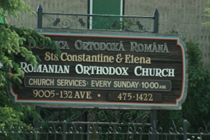
Saint Constantine the Great (306-337) was the son of the Caesar Constantius Chlorus (305-306), who governed the lands of Gaul and Britain. His mother was Saint Helen, a Christian, born probably at Drepanum (Helenopolis) in Asia Minor to parents of humble means.
At this time the vast Roman Empire was divided into Western and Eastern halves, governed by two independent emperors and their corulers were called “Caesars.” Constantius Chlorus was Caesar in the Western Roman Empire. St. Constantine was born in 274, possibly at Nish. In 294, Constantius divorced Helen in order to further his political ambition by marrying a woman of noble rank. After he became emperor, Constantine showed his mother great honor and respect, granting her the imperial title “Augusta.”
Constantine, the future ruler of the whole Roman Empire, was raised to respect Christianity. His father did not persecute Christians in the lands he governed. This was at a time when Christians were persecuted throughout the Roman Empire by the emperors Diocletian (284-305) and his corulers Maximian Galerius (305-311) in the East, and the emperor Maximian Hercules (284-305) in the West.
After the death of Constantius Chlorus in 306, Constantine was acclaimed by the army at York as emperor of Gaul and Britain. The first act of the new emperor was to grant the freedom to practice Christianity in the lands subject to him. The pagan Maximian Galerius in the East and the fierce tyrant Maxentius in the West hated Constantine and they plotted to overthrow and kill him, but Constantine bested them in a series of battles, defeating his opponents with the help of God. He prayed to God to give him a sign which would inspire his army to fight valiantly, and the Lord showed him a radiant Sign of the Cross in the heavens with the inscription “In this Sign, conquer.”
After Constantine became the sole ruler of the Western Roman Empire, he issued the Edict of Milan in 313 which guaranteed religious tolerance for Christians. St Helen, who was a Christian, may have influenced him in this decision. In 323, when he became the sole ruler of the entire Roman Empire, he extended the provisions of the Edict of Milan to the Eastern half of the Empire. After three hundred years of persecution, Christians could finally practice their faith without fear.
The Emperor transferred his capital to the East, to the city of Byzantium, which was renamed Constantinople (the city of Constantine). Constantine was deeply convinced that only Christianity could unify the immense Roman Empire with its diverse peoples. He supported the Church in every way. He recalled Christian confessors from banishment and built churches.
The emperor deeply revered the victory-bearing Sign of the Cross of the Lord, and also wanted to find the actual Cross upon which our Lord Jesus Christ was crucified. For this purpose he sent his own mother, the holy Empress Helen, to Jerusalem, granting her both power and money. Patriarch Macarius of Jerusalem and St Helen began the search, and through the will of God, the Life-Creating Cross was miraculously discovered in 326. St Helen gave the Life-Creating Cross to the Patriarch, who elevated it to be seen by the multitude of Christians. The Orthodox Church celebrates this event every year, on September 14, when the “Elevation of the Holy Cross” is observed. The emperor Constantine ordered a magnificent church in honor of Christ’s Resurrection to be built over His tomb. St. Empress Helen returned to Constantinople, where she died in the year 327.
The peaceful state of the Christian Church was disturbed by quarrels, dissensions and heresies, which had appeared within the Church. Particularly dangerous for the Church was the rise of the Arian heresy in the East, which denied the divine nature of the Son of God, and taught that Jesus Christ was a mere creature. By order of the emperor, the First Ecumenical Council was convened in the city of Nicea in 325. An impressive number of 318 bishops attended this Council, among them, St. Nicholas of Myra in Lycia. The heresy of Arius was condemned and the Symbol of Faith (Creed) composed, which included the term “consubstantial with the Father,” confirming the truth of the divinity of Jesus Christ, who assumed human nature for the redemption of the human race.
After the Council of Nicea, St. Constantine continued to have an active role in the welfare of the Church. He accepted holy Baptism on his deathbed, having prepared for it all his life. St. Constantine died on the day of Pentecost in the year 337 and was buried in the church of the Holy Apostles, in a crypt he had prepared for himself.
Given the important role they played in defending the Christian faith, the historians gave St. Constantine the title of “the Great,” and the Church confered upon them the title of “Equal to the Apostles.”


 English
English Română
Română